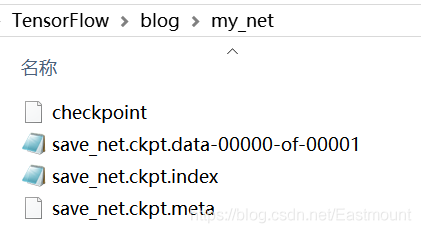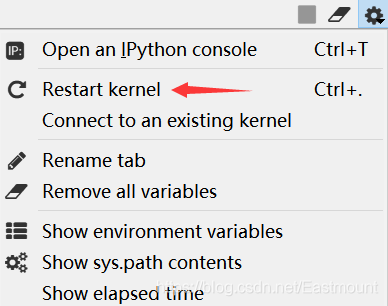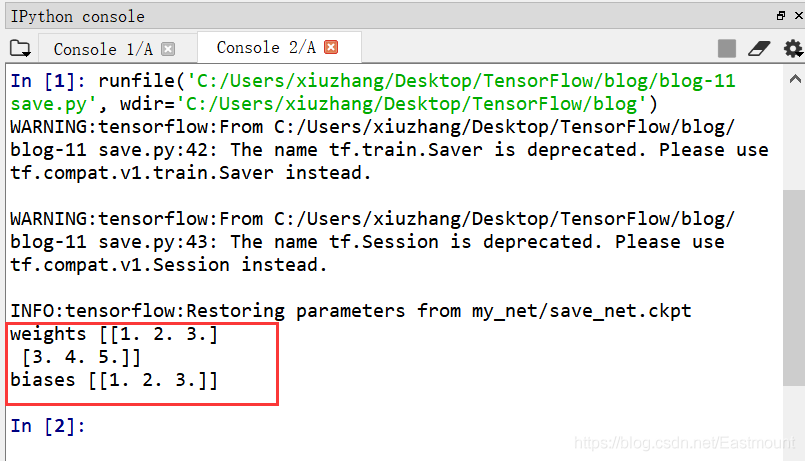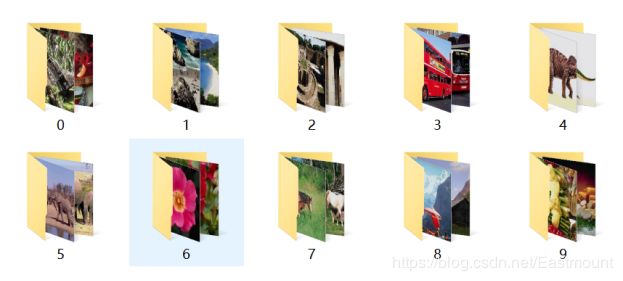Tensorflow 保存神经网络参数有妙招:Saver 和 Restore
摘要:这篇文章将讲解 TensorFlow 如何保存变量和神经网络参数,通过 Saver 保存神经网络,再通过 Restore 调用训练好的神经网络。
本文分享自华为云社区《[Python人工智能] 十一.Tensorflow如何保存神经网络参数 丨【百变AI秀】》,作者:eastmount。
一、保存变量
通过 tf.Variable()定义权重和偏置变量,然后调用 tf.train.Saver()存储变量,将数据保存至本地“my_net/save_net.ckpt”文件中。
# -*- coding: utf-8 -*-"""Created on Thu Jan 2 20:04:57 2020@author: xiuzhang Eastmount CSDN"""import tensorflow as tfimport numpy as np
#---------------------------------------保存文件---------------------------------------W = tf.Variable([[1,2,3], [3,4,5]], dtype=tf.float32, name='weights') #2行3列的数据b = tf.Variable([[1,2,3]], dtype=tf.float32, name='biases')
# 初始化init = tf.initialize_all_variables()
# 定义saver 存储各种变量saver = tf.train.Saver()
# 使用Session运行初始化with tf.Session() as sess: sess.run(init) # 保存 官方保存格式为ckpt save_path = saver.save(sess, "my_net/save_net.ckpt") print("Save to path:", save_path)“Save to path:my_net/save_net.ckpt”保存成功如下图所示:

打开内容如下图所示:

接着定义标记变量 train,通过 Restore 操作使用我们保存好的变量。注意,在 Restore 时需要定义相同的 dtype 和 shape,不需要再定义 init。最后直接通过 saver.restore(sess, “my_net/save_net.ckpt”) 提取保存的变量并输出即可。
# -*- coding: utf-8 -*-"""Created on Thu Jan 2 20:04:57 2020@author: xiuzhang Eastmount CSDN"""import tensorflow as tfimport numpy as np
# 标记变量train = False
#---------------------------------------保存文件---------------------------------------# Saveif train==True: # 定义变量 W = tf.Variable([[1,2,3], [3,4,5]], dtype=tf.float32, name='weights') #2行3列的数据 b = tf.Variable([[1,2,3]], dtype=tf.float32, name='biases')
# 初始化 init = tf.global_variables_initializer() # 定义saver 存储各种变量 saver = tf.train.Saver() # 使用Session运行初始化 with tf.Session() as sess: sess.run(init) # 保存 官方保存格式为ckpt save_path = saver.save(sess, "my_net/save_net.ckpt") print("Save to path:", save_path)#---------------------------------------Restore变量-------------------------------------# Restoreif train==False: # 记住在Restore时定义相同的dtype和shape # redefine the same shape and same type for your variables W = tf.Variable(np.arange(6).reshape((2,3)), dtype=tf.float32, name='weights') #空变量 b = tf.Variable(np.arange(3).reshape((1,3)), dtype=tf.float32, name='biases') #空变量 # Restore不需要定义init saver = tf.train.Saver() with tf.Session() as sess: # 提取保存的变量 saver.restore(sess, "my_net/save_net.ckpt") # 寻找相同名字和标识的变量并存储在W和b中 print("weights", sess.run(W)) print("biases", sess.run(b))运行代码,如果报错“NotFoundError: Restoring from checkpoint failed. This ismost likely due to a Variable name or other graph key that is missing from thecheckpoint. Please ensure that you have not altered the graph expected based onthe checkpoint. ”,则需要重置 Spyder 即可。

最后输出之前所保存的变量,weights 为 [[1,2,3],[3,4,5]],偏置为 [[1,2,3]]。

二、保存神经网络
那么,TensorFlow 如何保存我们的神经网络框架呢?我们需要把整个网络训练好再进行保存,其方法和上面类似,完整代码如下:
"""Created on Sun Dec 29 19:21:08 2019@author: xiuzhang Eastmount CSDN"""import osimport globimport cv2import numpy as npimport tensorflow as tf
# 定义图片路径path = 'photo/'
#---------------------------------第一步 读取图像-----------------------------------def read_img(path): cate = [path + x for x in os.listdir(path) if os.path.isdir(path + x)] imgs = [] labels = [] fpath = [] for idx, folder in enumerate(cate): # 遍历整个目录判断每个文件是不是符合 for im in glob.glob(folder + '/*.jpg'): #print('reading the images:%s' % (im)) img = cv2.imread(im) #调用opencv库读取像素点 img = cv2.resize(img, (32, 32)) #图像像素大小一致 imgs.append(img) #图像数据 labels.append(idx) #图像类标 fpath.append(path+im) #图像路径名 #print(path+im, idx) return np.asarray(fpath, np.string_), np.asarray(imgs, np.float32), np.asarray(labels, np.int32)
# 读取图像fpaths, data, label = read_img(path)print(data.shape) # (1000, 256, 256, 3)# 计算有多少类图片num_classes = len(set(label))print(num_classes)
# 生成等差数列随机调整图像顺序num_example = data.shape[0]arr = np.arange(num_example)np.random.shuffle(arr)data = data[arr]label = label[arr]fpaths = fpaths[arr]
# 拆分训练集和测试集 80%训练集 20%测试集ratio = 0.8s = np.int(num_example * ratio)x_train = data[:s]y_train = label[:s]fpaths_train = fpaths[:s] x_val = data[s:]y_val = label[s:]fpaths_test = fpaths[s:] print(len(x_train),len(y_train),len(x_val),len(y_val)) #800 800 200 200print(y_val)#---------------------------------第二步 建立神经网络-----------------------------------# 定义Placeholderxs = tf.placeholder(tf.float32, [None, 32, 32, 3]) #每张图片32*32*3个点ys = tf.placeholder(tf.int32, [None]) #每个样本有1个输出# 存放DropOut参数的容器 drop = tf.placeholder(tf.float32) #训练时为0.25 测试时为0
# 定义卷积层 conv0conv0 = tf.layers.conv2d(xs, 20, 5, activation=tf.nn.relu) #20个卷积核 卷积核大小为5 Relu激活# 定义max-pooling层 pool0pool0 = tf.layers.max_pooling2d(conv0, [2, 2], [2, 2]) #pooling窗口为2x2 步长为2x2print("Layer0:\n", conv0, pool0) # 定义卷积层 conv1conv1 = tf.layers.conv2d(pool0, 40, 4, activation=tf.nn.relu) #40个卷积核 卷积核大小为4 Relu激活# 定义max-pooling层 pool1pool1 = tf.layers.max_pooling2d(conv1, [2, 2], [2, 2]) #pooling窗口为2x2 步长为2x2print("Layer1:\n", conv1, pool1)
# 将3维特征转换为1维向量flatten = tf.layers.flatten(pool1)
# 全连接层 转换为长度为400的特征向量fc = tf.layers.dense(flatten, 400, activation=tf.nn.relu)print("Layer2:\n", fc)
# 加上DropOut防止过拟合dropout_fc = tf.layers.dropout(fc, drop)
# 未激活的输出层logits = tf.layers.dense(dropout_fc, num_classes)print("Output:\n", logits)
# 定义输出结果predicted_labels = tf.arg_max(logits, 1)#---------------------------------第三步 定义损失函数和优化器---------------------------------
# 利用交叉熵定义损失losses = tf.nn.softmax_cross_entropy_with_logits( labels = tf.one_hot(ys, num_classes), #将input转化为one-hot类型数据输出 logits = logits)
# 平均损失mean_loss = tf.reduce_mean(losses)
# 定义优化器 学习效率设置为0.0001optimizer = tf.train.AdamOptimizer(learning_rate=1e-4).minimize(losses)#------------------------------------第四步 模型训练和预测-----------------------------------# 用于保存和载入模型saver = tf.train.Saver()# 训练或预测train = False# 模型文件路径model_path = "model/image_model"
with tf.Session() as sess: if train: print("训练模式") # 训练初始化参数 sess.run(tf.global_variables_initializer()) # 定义输入和Label以填充容器 训练时dropout为0.25 train_feed_dict = { xs: x_train, ys: y_train, drop: 0.25 } # 训练学习1000次 for step in range(1000): _, mean_loss_val = sess.run([optimizer, mean_loss], feed_dict=train_feed_dict) if step % 50 == 0: #每隔50次输出一次结果 print("step = {}\t mean loss = {}".format(step, mean_loss_val)) # 保存模型 saver.save(sess, model_path) print("训练结束,保存模型到{}".format(model_path)) else: print("测试模式") # 测试载入参数 saver.restore(sess, model_path) print("从{}载入模型".format(model_path)) # label和名称的对照关系 label_name_dict = { 0: "人类", 1: "沙滩", 2: "建筑", 3: "公交", 4: "恐龙", 5: "大象", 6: "花朵", 7: "野马", 8: "雪山", 9: "美食" } # 定义输入和Label以填充容器 测试时dropout为0 test_feed_dict = { xs: x_val, ys: y_val, drop: 0 } # 真实label与模型预测label predicted_labels_val = sess.run(predicted_labels, feed_dict=test_feed_dict) for fpath, real_label, predicted_label in zip(fpaths_test, y_val, predicted_labels_val): # 将label id转换为label名 real_label_name = label_name_dict[real_label] predicted_label_name = label_name_dict[predicted_label] print("{}\t{} => {}".format(fpath, real_label_name, predicted_label_name)) # 评价结果 print("正确预测个数:", sum(y_val==predicted_labels_val)) print("准确度为:", 1.0*sum(y_val==predicted_labels_val) / len(y_val))核心步骤为:
saver = tf.train.Saver()model_path = "model/image_model"with tf.Session() as sess: if train: #保存神经网络 sess.run(tf.global_variables_initializer()) for step in range(1000): _, mean_loss_val = sess.run([optimizer, mean_loss], feed_dict=train_feed_dict) if step % 50 == 0: print("step = {}\t mean loss = {}".format(step, mean_loss_val)) saver.save(sess, model_path) else: #载入神经网络 saver.restore(sess, model_path) predicted_labels_val = sess.run(predicted_labels, feed_dict=test_feed_dict) for fpath, real_label, predicted_label in zip(fpaths_test, y_val, predicted_labels_val): real_label_name = label_name_dict[real_label] predicted_label_name = label_name_dict[predicted_label] print("{}\t{} => {}".format(fpath, real_label_name, predicted_label_name)) 预测输出结果如下图所示,最终预测正确 181 张图片,准确度为 0.905。相比之前机器学习 KNN 的 0.500 有非常高的提升。

测试模式INFO:tensorflow:Restoring parameters from model/image_model从model/image_model载入模型b'photo/photo/3\\335.jpg' 公交 => 公交b'photo/photo/1\\129.jpg' 沙滩 => 沙滩b'photo/photo/7\\740.jpg' 野马 => 野马b'photo/photo/5\\564.jpg' 大象 => 大象...b'photo/photo/9\\974.jpg' 美食 => 美食b'photo/photo/2\\220.jpg' 建筑 => 公交b'photo/photo/9\\912.jpg' 美食 => 美食b'photo/photo/4\\459.jpg' 恐龙 => 恐龙b'photo/photo/5\\525.jpg' 大象 => 大象b'photo/photo/0\\44.jpg' 人类 => 人类
正确预测个数: 181准确度为: 0.905版权声明: 本文为 InfoQ 作者【华为云开发者社区】的原创文章。
原文链接:【http://xie.infoq.cn/article/4892efd3101db9cd0d6cbbd40】。文章转载请联系作者。
华为云开发者社区
提供全面深入的云计算技术干货 2020.07.14 加入
华为云开发者社区,提供全面深入的云计算前景分析、丰富的技术干货、程序样例,分享华为云前沿资讯动态,方便开发者快速成长与发展,欢迎提问、互动,多方位了解云计算! 传送门:https://bbs.huaweicloud.com/












评论